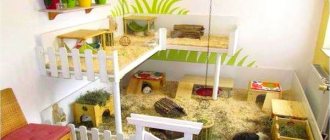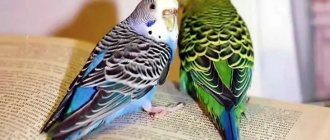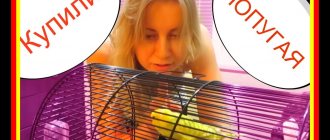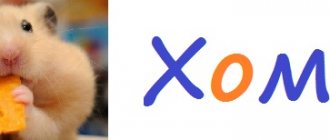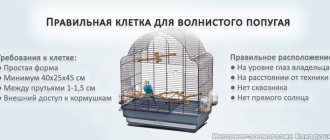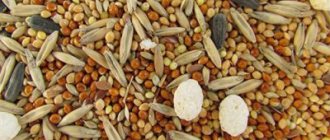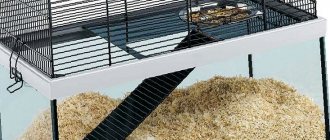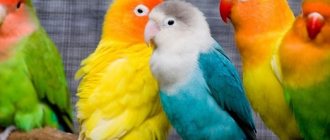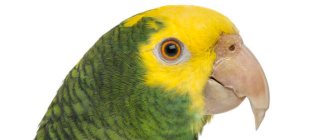Budgerigars are successfully kept at home - beautiful birds with a peaceful and curious character. They get along well with people and do not feel much discomfort in captivity, but for this it is necessary to create appropriate conditions for their life.
When purchasing a parrot for your home, you should immediately buy a cage for it, where it will spend a significant part of its time. The choice of this accessory should be taken with full responsibility, since the health and lifespan of your feathered friend depend on the conditions of detention.
In the article we will tell you what a cage for a budgie should be like, the optimal design, dimensions, material, what a budgie needs in a cage, mandatory items and additional accessories for organizing the space, where it is best to place the cage with a parrot, whether it needs to be covered with a cloth at night .
Dwelling size
For budgies
Miniature birds in a cramped cage will not feel comfortable, especially if the pet is not alone there. Restriction in movement will not lead to good things. Obesity can even occur, which is very dangerous for the health of children, whom nature ordered to be playful and active.
Cages for budgies
For the cockatiel
This parrot needs to have a rectangular house, without domes, and there should be no enamel in the decoration. But the more exits and entrances, the better. It will cost a pretty penny, but the convenience for the bird is worth any expense. In addition, the cage needs to be long, at least sixty centimeters for a single person. The width is forty-five and the same height.
Choosing a cage for a cockatiel
For a couple, the length should be up to a meter. Corella likes to fly horizontally, two or three beats of its wings inside the cage should be obtained. The rods on the walls are arranged in the same way - parrots climb on them, but with vertical rods this is impossible. Clearances in the lattice of more than three centimeters are not needed; the feathered climber will need to take too wide steps.
Read also
Why did the parrot become aggressive and bite?
For Grays
For large birds, the house must be spacious. In industry, those responsible for assortment, unfortunately, do not listen to the needs of breeders. The maximum cell sizes that are commercially available are 65x45x80.
Gray cages
Even for one Gray this area is not enough, but there is nothing to choose from. This parrot has high intelligence and an exceptionally powerful beak. Combined, you get a vandal!
Therefore, the rods must be strong and durable, the feeders must be secured, and the doors must close securely. The gray latch opens a regular latch much faster than the owner closes it. And an even more important condition: choose a cage equipped with protection against debris.
For lovebirds
- If a bird can spread its wings inside to the limit, it has the right home.
Basic parameters of a cage for lovebirds - The shape is preferably rectangular. In the round parrots cease to correctly navigate in space. The roof can be anything - flat or domed.
- A plastic bottom and a chrome-plated metal top is the best option. Lovebirds chew up the tree. You can’t make it from copper, it oxidizes and is poison for any birds.
- It is better to place it near the wall, so the pets feel protected. Choose the height at eye level. It's good to have a special stand. There should be no drafts in this place, and no heating radiators nearby. The accommodation is stationary; any relocation causes a commotion among the small birds.
- Lovebirds are curious and try to get into everything. Therefore, a distance of about one and a half centimeters between the bars will prevent the baby from getting injured when trying to dive into the gap.
- The most convenient is a pull-out tray made of iron or aluminum.
For cockatoos
The parameters are the same as for the Gray parrot and other large parrots.
Choosing a cage for a cockatoo
Perches for budgies
A standard cage for one budgie can usually accommodate two or three perches. It is worth fixing them at different levels, and the top one should be at a comfortable distance from the ceiling, since this is what the bird will choose as a sleeping place. When placing, keep in mind that the lower pole should not be directly under the top one, otherwise the pet will constantly dirty it. It is better to place the perches at a vertical and horizontal distance from the bird, so that it can easily flutter between them and stretch its wings.
According to their purpose, perches can be basic or specialized, as well as artificial and made from natural materials. Basic perches are used for permanent residence of the parrot, while specialized ones are usually needed for grinding down the beak and claws, heating, quarantine, and other things.
Typically, the following types of perches are installed in the cages of budgies:
1. Plastic. These are temporary, sometimes hollow inside, additives that are often included in cages for sale. They are well suited for organizing quarantine because they are easy to sterilize and disinfect, wash well and do not accumulate detergents. But with prolonged use, problems arise: the birds do not grind down their claws, rub calluses on their paws, overwork their muscles, which leads to early diseases of the musculoskeletal system and falls from the perch. They can also be a source of parasitic infestation.
2. Flexible (including rubberized). Modular structures are also made of plastic and have corresponding disadvantages. Sometimes on sale you can find perches covered with rubber, but most parrots deal with it without difficulty. Modular perches help change the “interior” of the cage, allow you to organize space for several birds and provide them with access to important objects (feeders, drinkers, toys) without unnecessary clutter in the house.
3. Industrial wood. Such perches are equipped with a reliable fastening using a nut or a longitudinal cutout and are made of harmless material. A large selection of diameters and textures allows you to provide your parrot with an optimal set of attachments. But remember that smooth polished poles increase the load on certain areas of the foot - it is better to choose uneven poles or at least options with a rhombic cross-section.
4. Filamentous. Typically, in the center of such products there is a wire, thanks to which their shape can be changed. The outside is lined with cotton cord. Unfortunately, parrots love to fray such poles, mistaking them for toys. If birds become entangled in threads with their beaks or claws, they can be seriously injured or even die.
5. Cement, volcanic or sand-coated. These attachments are intended exclusively for grinding down the beak and claws and help avoid the unpleasant manipulations of trimming them. All you need in a cage is this kind of perch, and it should be located at the lower levels, otherwise the bird’s paws will be constantly irritated.
6. Heated. Such devices are rare in apartments and are more popular in enclosures. It is risky to buy them for a pet parrot - with a high probability the bird will destroy the insulation and get to the conductive elements.
7. Natural wood. Currently the most popular, useful and cheapest option. Tree bark contains fiber, cellulose, some micro- and macroelements, serves as a valuable enterosorbent, and can also keep your pet occupied for a long time. In nature, budgies often eat bark, even when there is an abundance of other food, as feeding, and use it to grind down their beaks.
Branches should be harvested away from the roadway and sources of pollution - in forests, remote parks, botanical gardens, and dachas. However, many wild birds live in these places, so natural perches need pre-treatment. Do not cut branches treated with pesticides or other chemicals! Select a branch with a diameter of 1.2 to 1.8 cm, free of mosses, lichens, woodworms and other tree diseases, so that the planting does not cause fungal or bacterial disease. Then rinse it thoroughly, pour boiling water over it or bake it in the oven (the thicker the branch, the longer the procedure) and dry for 24 hours.
Your pet will certainly appreciate a perch made from branches of fruit trees and shrubs (apple tree, cherry, plum, apricot, viburnum, rowan, hawthorn, currant, raspberry, citrus), as well as from aspen, ash, birch, willow, alder, maple, linden, hornbeam, beech. Under no circumstances should you make a perch from oak, pear, bird cherry, poplar, lilac, elderberry, or acacia wood.
The optimal thickness of the perch is determined as follows: the bird should grasp it 2/3 or 3/4, while touching the perch with its claws. A pole that is too thin will result in overgrown nails, while a pole that is too thick will tire the paws. Preferable attachments are of different thicknesses, which are replaced as the bark is nibbled.
Where is the best place to place the cage?
The place should be as well lit as possible, although direct sunlight is unacceptable, as it is extremely harmful to all breeds of parrots. We need to remind you about drafts again; they most often lead to the death of southern beauties.
The air temperature must be maintained at 25 degrees; if it drops, the birds will be chilly and catch a cold. It is better not to have birds at all in a damp room.
Where should you place a parrot cage?
All pets love communication, without which they get bored and sad. Their habitat must be chosen according to this feature: in the room where people relax, in the dining room or living room. However, the cage should not interfere with anyone.
It is better to place it away from the door: I can remember any number of tragic cases when a little wavy did not have time to follow its owner, the door closed and injured him. Igor Ignatenkov
Lighting
Any living creature adheres to a certain daily routine. The same goes for wavy ones. In the summer seasons, the duration of daylight should be at least 12 hours, in winter - from 10. If it is not possible to fulfill these conditions in natural ways, artificial lighting sources will come to the rescue, the choice of which will require time. It is better to seal the windows with paper in advance, since ultraviolet radiation is very dangerous for wavy birds.
Daylight.
Artificial lighting.
Parrots are quite conservative in their daily routine - they need rest from nine in the evening to nine in the morning, but few people can rest as much as budgerigars. Due to insufficient sleep, birds get sick more often, become less active, and can become depressed and nervous. To avoid such problems, you need to buy lightproof fabric in advance and cover the bird’s cage at night. This will help the pet fall asleep faster and also protect the owner from cheerful chirping in the morning.
Feeders and drinkers
A pet needs different types of food: soft, mineral and grain. And that’s not all: you need to separately add charcoal, eggshells, and river sand, which are necessary for the normal functioning of the digestive system.
Read also
How to name a boy's budgerigar list of names
It is impossible to put all this in one bowl. For food, three containers are usually purchased and installed at once. They must be made of stainless steel and of suitable size. So are drinking bowls.
The optimal choice of bird house
The bird must have a cage of optimal size and shape. Pet stores sell products that can satisfy the wishes of any customer. Cells differ in shape, size and internal structure. But not all such models are safe and easy to use.
When choosing a cage, it is recommended to focus on the following parameters:
Form. Experienced ornithologists recommend buying rectangular cages for wavy birds. Angles have a positive effect on the bird’s psyche, as it feels safe. It is advisable to place one side of the cage against the wall, which will allow the pet to relax and calm down if necessary. A round structure is not suitable for wavy birds, as it creates the illusion of space, but it is inconvenient for the bird to climb curved walls.- Dimensions. If you put your parrot in a cage that is too small, it will cause stress because the bird will not have enough free space to move around. This leads to shedding, apathy and decreased appetite. If a person plans to regularly let the bird out for a walk, then the height of the cage may not exceed 45 cm. But if the wavy will spend most of its life inside the cage, then a larger structure is purchased, the height of which starts from 55 cm.
- Material of manufacture . It is not recommended to buy painted or wooden cages. Wood dries out, swells and becomes moldy when exposed to water. Therefore, ideal conditions are created for the development of bacteria and parasites. Stainless steel products are considered the right choice. They should not have sharp corners, protrusions or roughness.
The cage is installed in a well-lit and warm place, but away from heating appliances and electrical devices.
Perches
Water and food should always be clean, and therefore the parrot is given a place to sit where it cannot shit in the feeder. All accessories are arranged in accordance with this principle.
Their size is very important, since clean paws are the key to health. Birds will readily peck at a perch made of wood, with a special appetite for a perch made from fruit. You need to think especially about the materials used to make accessories.
How to place a perch correctly
Stands
Entertaining play stands for pet budgies are made of wood and filled with ladders, swings, and hanging rings. Some people like to spend time jumping on wicker mesh ladders, while others like a jumble of rungs and perches. Play stands for wavy animals are located at a distance from the main home. On the territory of the site, the bird must learn to play, and eat and drink only in the nest. A short distance between the house and the stand will allow the bird to move and not lose its physical shape, which is important for pets in captivity.
Toys and mirrors
There are a lot of inexpensive Chinese consumer goods on sale, and poultry markets have also been completely conquered by them. Because of these cheap plastics we are losing our feathered pets. Parrots of all breeds chew on everything, like mongrel puppies.
And then they swallow plastic fragments and die. Owners need to check very carefully every item they decide to buy for their pet.
An excellent solution is metal bells that can be hung in a cage: ringing and fun for both people and birds. Offering mirrors is also dangerous: the beaks are strong, and the glass is fragile. If a sharp piece of glass is swallowed, you will not be able to survive. But the owner is the master, let him decide for himself.
On the question of the mirror
Contrary to the popular myth that a budgerigar will not learn to speak without a mirror, placing this accessory in a cage is unjustified. The absence of a “friend” often even stimulates the bird’s desire to communicate with the owner in his language (however, if you are the owner of a completely wild parrot, you should not impose human society on it - it is better to buy a comrade).
Placing a mirror in a cage is permissible only for those birds that understand that this is not a living relative, but just a toy. Otherwise, the wavy will try to establish contact with the reflection, but without receiving reciprocity, he will become nervous, irritable, aggressive, and feel rejected. There are cases where, mistaking a mirror for a partner, birds violently attacked the owner’s hands when trying to touch or move the toy. The same goes for toys in the shape of birds.
Occasionally, a mirror can be used to accustom a bird to a bath, new food and its owner - it is a useful tool in establishing contact. But with constant placement in a cage, neurosis and self-plucking are possible, as well as “sticking” to the reflection and lack of interest in the outside world. Also, you should not place the mirror where two or more parrots are kept together - it can become a reason for jealousy, conflicts and neglect of the real partner. When angry, the bird can seriously hurt itself on the mirror.
Tree branches
Plastic is in no way healthy for parrots. You need wooden perches; you can buy them or make them yourself from branches cut in the park. Large fragments of trees, from which a special stand for a pet is made on the wall, also look good in the apartment.
Tree branches that can be used for a parrot
Craftsmen carve swings for the cage and various toys. The branches for the perches must be of a certain thickness - enough to grip the paw by about three-quarters of the volume. Not every tree is suitable for chewing.
Leave acacia and lilac alone, which are poisonous to birds. You cannot take branches of oak, pear, or bird cherry because of the tannins they contain. Resinous conifers are also not suitable - none.
The coffee tree does not grow here, but you need to know that it is also prohibited. But poplar is widespread, which takes away all the most harmful, poisonous, and toxic things from the atmosphere. A real cleaner of the planet's territory. But parrots are not allowed to peck its branches.
Can be used:
- hawthorn;
- birch;
- cherry;
- elderberry;
- willow;
- linden;
- aspen.
Trees from which you can make perches for a parrot
Many other trees are also suitable.
Playground
To entertain your pet, you can equip a special play area. You can equip a playground for birds and budgies yourself or purchase a ready-made one. It is desirable that it be made of wood. A playground for birds should include a hanging ladder, a bridge, toys, and equipment for sharpening claws and beaks. All these items are mounted on the walls of the bird house. The space in the center is left free so as not to make it difficult for the feathered friend to fly. Within the wooden play area, you can place a small container of sand for the budgerigar’s fun games. It is necessary for the full development of the bird. Sand for birds is sold organic and inorganic. There is no need to use the latter type - there is no benefit from it; preference should be given to organic mineral sand intended for budgies. With its help, the bird will replenish the necessary supply of minerals. Purified bird sand is sold at pet stores in special packaging.
Before purchasing, carefully read its composition. It is better to take non-scented sand for birds.
Bathing
Budgerigars come from tropical rainforests and require careful care. There are special fountains where water gurgles, and the birds can bathe and cleanse themselves. You need to bathe the bird once a week. In summer you can 2-3 times a week if it is very hot.
Parrots love water, so if they want to swim, the owner will understand. For shy birds, you can pour water into a saucer and place it next to the cage. Let your pet become interested and take a bath.
If the wings get dirty with paint or other chemicals while flying around the apartment, you should trim them carefully.
Diet
Budgerigars have a varied diet. A balanced complex of nutrients and active substances will help you be completely healthy. Birds should be fed with special food from a pet store, but first the owner can consult with an ornithologist to choose a suitable grain mixture.
In addition to grain, birds should be given vitamins, which they can get from vegetables, fruits, cereals, herbs and nuts. Also, the bird’s body must receive macro and microelements, which should be given separately from complementary foods.
Food and vitamins should be consumed by your pet in certain doses. The grain mixture needs 2 tbsp. per day, as well as water and fruit.
Prohibited Products
Everything that the owner eats will not suit the budgerigar’s diet. You should absolutely not give them caffeine, alcohol or cocoa. This is deadly for the life of the pet. You should also not give baked goods, because the yeast will swell inside the stomach and cause gastrointestinal upset. In addition to these foods, pets should not eat fried, sweet or spicy foods. You can replace all this with a boiled chicken egg, just cook without adding salt.
If the owner decides to pamper the pet with berries or fruits containing a seed, then it must be removed, because... under the influence of moisture, hydrocyanic acid is formed, the consumption of which will also cause food poisoning.
It is also not recommended to give twigs of cherries or cherries, as the bird may choke.
Favorite Products
Budgerigars are not picky eaters, so you can give them what you like. Fruits and vegetables containing vitamins A and B, as well as boiled nuts and cereals. Budgerigars love to crunch, so the owner can safely eat an apple, carrots, cabbage and crackers made from whole grain bran without salt.
Which ones should not be given?
For a budgerigar, like other species of these birds, you cannot buy painted toys. Small pieces of paint can enter the stomach, thereby causing poisoning.
Also, the accessories should not have holes in which the bird could get its beak stuck. It is better if the material used to make toys is durable, otherwise the parrot will be able to crumble it.
It is worth paying attention to the presence of sharp corners. During play, your pet may get hurt on them.
